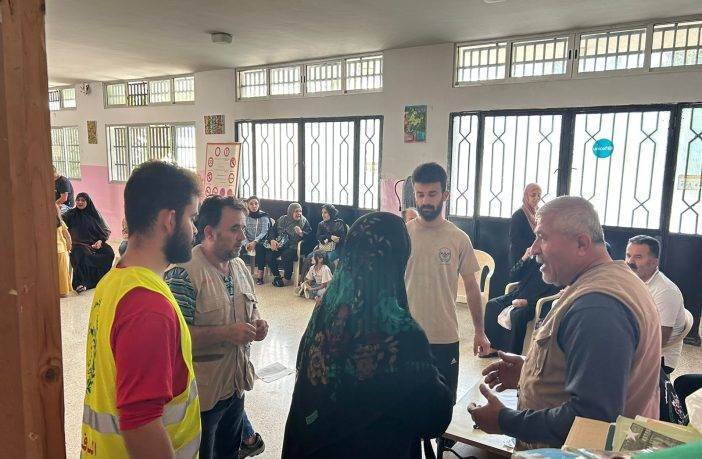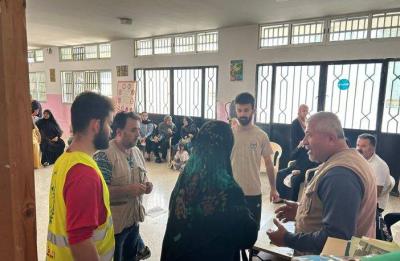The number of displaced persons from border villages and towns has risen to nearly 90,000, primarily distributed across the districts of Tyre, Nabatieh, and Sidon. One recurring question voiced by displaced children to their families is, "When will we return to our homes and schools?" Neither the families nor the officials have an answer to this question since mid-October, following a gradual increase in the number of displaced persons from the villages and towns of the Tyre, Bint Jbeil, and Marjeyoun districts.
The temporary residence of these displaced individuals has extended far beyond the last instances of displacement that lasted from July 13 to August 14, 2006. It is not new for southerners, particularly those from what is known as the boundary strip, to flee their towns and villages. Although they have experienced waves of displacement since the 1970s, the current wave is different due to significant changes in economic conditions and the lack of a prospect for calm. Traditionally, displacement was due to Israeli assaults on the south, but today the circumstances are complicated by dual aggression—first against Gaza and second against southern Lebanon—resulting in an undefined time frame for displacement given the complexities within Palestine and the insistence of the occupying army to continue its aggression against Gaza, linking any calm on the southern Lebanese border to a ceasefire in Gaza.
The number of displaced persons from the south has been steadily increasing with the escalation of Israeli attacks, which are not limited to what is now referred to as the front line, namely the towns and villages adjacent to the border, extending from Naqoura to Wazzani, passing through Aita Shaab, Ramish, Aitaroun, and Hula. While the number of displaced persons in October was around 15,000, it rose to 26,000 in November, about 70,000 in December, and stabilized at 86,000 at the beginning of the year, currently reaching nearly 90,000.
According to "International Organization for Migration" data, around 86,000 people have fled from high-risk areas to safer locations. The high-risk areas are those towns adjacent to the border, including Naqoura, Alma Shaab, Al-Dahiya, Yarin, Al-Bustan, Um Tu'tu, and Marwihin in the western sector. In the central sector, they include Ramiyeh, Aita Shaab, Ramish, Ain Ibl, Yaroun, Maroun Ras, Aitaroun, Blida, Mais Al-Jabal, Hula, Markaba, Al-Adissyah, Kfarkla, and the remaining villages in the eastern sector stretching from Khiam to Kafrshuba passing through Wazzani, Al-Abbasiya, Halta, and Al-Fardis, among others.
Currently, the displaced are primarily distributed across the districts of Tyre, Nabatieh, and Sidon as follows: Tyre 25,601, Nabatieh 23,581, and Sidon 13,086. In Mount Lebanon, most displaced persons are in Baabda, where their number approaches 8,000, followed by Aley with 4,700, Chouf 2,080, Metn around 1,000, Jbeil 3,700, and approximately 6,500 have fled to Beirut. The remaining individuals have spread across West Bekaa, Baalbek, and Hermel, as well as villages in the Bint Jbeil district away from the frontline, and some displaced individuals have reached Tripoli and Batroun.
As for securing housing for the displaced, a significant portion has been divided among host families (about two-thirds of the displaced), over 15% have rented homes or apartments, about 4% have moved to homes they own outside conflict areas, and nearly 2% have sought refuge in collective shelters (schools and other institutions). Displacement rates vary between towns; while towns on the front line have seen displacement rates exceeding 70%, other villages report displacement rates around 50%, with completely empty borders of the towns.
Regarding assistance for the displaced, registered displaced persons benefit from the provisions offered by official institutions through disaster management programs and charitable organizations, as well as what expatriates send. According to those monitoring the displacement issue, assistance remains modest from associations and local and international organizations, covering less than 50% of needs. The type of aid ranges from monthly financial amounts (100 dollars), to food and cleaning supplies, and necessities for infants like milk and diapers.
However, another type of assistance chosen by "Sanabel Al-Khayr Association" is to help small farmers, as noted by its president Ali Khalil Bzi, providing a monthly amount of 200 dollars to 70 farmers in the towns of Aitaroun, Ramish, Dibl, Maroun, and Bint Jbeil as a small compensation for the losses they have incurred.
Furthermore, there are displaced individuals who do not receive any assistance either due to not registering with the competent authorities or not communicating with local official or party representatives, or due to negligence, as indicated in "An-Nahar". The current period of displacement is considered to be the harshest due to the difficult economic conditions Lebanon has faced for over four years, in addition to families that could not flee due to the lack of money for transportation and related expenses. There are also families that were unable to flee for other reasons, including the unavailability of space to transport livestock or poultry, thus preferring to stay in border villages. Moreover, those who were forced to sell their livestock and poultry at very low prices or incurred high transportation costs to move them away from confrontation, experienced significant hidden losses. Additionally, some were compelled to flee and leave their poultry and livestock at the mercy of hunger or stray dogs.




